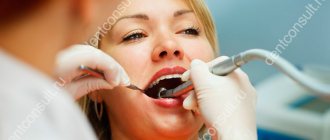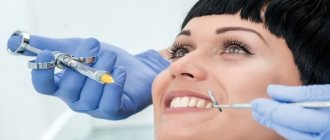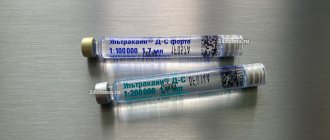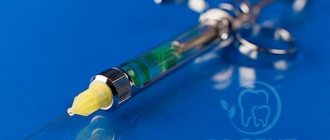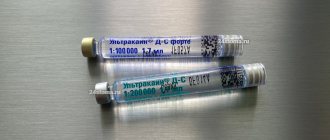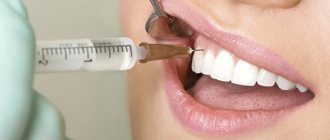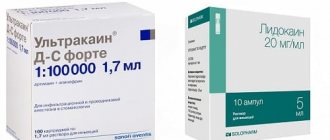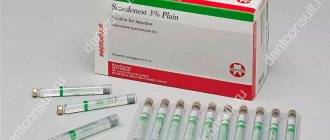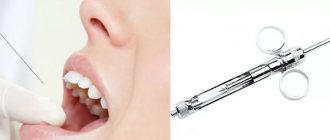Pharmacodynamics and pharmacokinetics
Articaine is a thiophene and has a local anesthetic effect. Used for conduction and infiltration anesthesia . Articaine undergoes hydrolysis in a slightly alkaline environment of tissues with the release of a base that has lipophilic properties, and therefore easily penetrates through the cell membrane into the nerve fiber.
By influencing receptors, it blocks the delivery of sodium ions into the cell and the conduction of impulses along nerve fibers. The effect of the drug is observed immediately after its administration and lasts from 1 to 3 hours. Efficiency is reduced in acidic environments.
When administered intramuscularly, Cmax is achieved within 20 to 40 minutes.
When introduced under the mucous membrane of the oral cavity, it exhibits high diffusion ability.
95% bound to plasma proteins.
Metabolized in the liver, T½ is approximately 60 – 80 minutes.
Within 6 hours, 54 - 63% is excreted by the kidneys.
Can penetrate the placental barrier (to a lesser extent than other local anesthetics); it penetrates the blood-brain barrier in small quantities. It is practically not excreted in breast milk.
Articaine during pregnancy in dentistry
Articaine is usually well tolerated at all stages of pregnancy. There is no data on the long-term effects of the drug on the neurophysiology of the newborn. Also, no teratogenic damage was observed after use of the drug in the first trimester.
There are no data from clinical studies of the penetration of Articaine into breast milk. To minimize possible risk to the baby, breastfeeding mothers may choose to express milk for approximately 4 hours after the injection. After which breastfeeding can be resumed.
Contraindications
- children under 4 years of age;
- increased sensitivity to local anesthetics of the amide group;
- paroxysmal tachycardia;
- B12 deficiency anemia (megaloblastic);
- angle-closure glaucoma;
- atrial fibrillation;
- bronchial asthma;
- chronic hypoxia.
Prescribe with caution:
- for pathologies of the central nervous system;
- with pseudocholinesterase deficiency;
- with pernicious anemia;
- with hypoxia.
Side effects
Peripheral and central nervous system:
- headache;
- dyspnea;
- visual impairment;
- apnea;
- muscle twitching;
- tremor;
- convulsions;
- diplopia;
- disturbance of consciousness.
The cardiovascular system:
- bradycardia;
- tachycardia;
- decrease in blood pressure.
Digestive system:
- nausea;
- diarrhea;
- vomit.
Allergic manifestations:
- itching;
- skin rash;
- angioedema;
- very rarely - anaphylactic shock.
Instructions for use of Articaine (Method and dosage)
The instructions for Articaine in dentistry suggest an individual dosage regimen, depending on the severity of the procedure, the time of its implementation and the patient’s tolerability of the drug.
The maximum single dose of the drug is 6 mg per kilogram of body weight.
To carry out surgical intervention, which requires more time than Articaine can provide, a combination drug is used - Articaine Inibsa Epinephrine as active ingredients . Epinephrine exhibits a vasoconstrictor effect at the site of drug administration, thereby increasing its absorption time, prolonging its effect.
Instructions for use of the drug Articaine Epinephrine in dentistry recommend the following doses of the drug.
During the procedure for removing teeth of the upper jaw without complications and inflammation - 1.7 ml of the drug per tooth, if ineffective, another 1 ml - 1.7 ml.
For a palatal incision or suture - 0.1 ml.
When grinding teeth to install crowns or prepare cavities, a vestibular injection is given in a dose of 0.5 ml - 1.7 ml for each tooth.
During the procedure for removing premolars of the lower jaw without complications, infiltration anesthesia , which acts as a conduction anesthesia.
The maximum dose in dentistry for adult patients is 7 mg per kilogram of weight. For pediatric patients over 4 years of age - 5 mg per kilogram of body weight.
What is Articaine and what is its composition?
Articaine is an amide anesthetic intended for local, infiltrative or conductive anesthesia for both simple and complex dental procedures. A local anesthetic blocks the generation and conduction of nerve impulses, presumably by increasing the threshold of electrical excitation in the nerve, slowing the propagation of the nerve impulse, and decreasing the rate of rise of the action potential.
The uniqueness of Articaine as a member of the amide family is that it contains an ester group and a thiophene instead of a benzene ring. The thiophene ring increases the lipid solubility of articaine, facilitating more efficient diffusion of the anesthetic across the lipid membrane of nerve cells into surrounding tissues. Articaine is widely used in dentistry due to its safety during short procedures that require rapid onset of anesthesia.
The onset of action of the drug Articaine is:
- from 1.5 to 1.8 min. with infiltration of the upper jaw;
- from 1.5 to 3.6 min. with block anesthesia of the lower jaw.
Articaine pulp anesthesia lasts from 30 to 120 minutes. Anesthesia of soft tissues with the drug lasts ~ 2.25 hours for infiltration of the upper jaw, 4 hours for blockade of the lower jaw.
The drug is produced in the form of an injection solution - a transparent, colorless or yellowish liquid. For retail sale to pharmacy chains, Articaine is supplied in ampoules made of colorless chemically pure glass, enclosed in blister packs and/or cardboard packs.
Composition of articaine in dentistry:
- active agent - articaine hydrochloride;
- Excipients: sodium chloride (to make the solution isotonic) and distilled water.
1 ml of solution contains 40 mg of active agent.
In odonto-dental anesthesia, articaine is used alone or in combination with epinephrine (adrenaline). Epinephrine, diluted to 1:100,000 or 1:200,000 and added to the solution, slows down the passage of articaine into the general bloodstream and thus ensures long-term maintenance of the concentration of the active substance in the tissues, allowing a small hemorrhagic surgical field to be obtained.
It is possible to replace Articaine with synonyms with the same active substance, such as:
- Artikain-Binergy;
- Ultracaine;
- Artikain-DF;
- Articaine with Epinephrine.
The decision to use analogues is made by the attending physician, taking into account the individual characteristics of the patient.
Overdose
, dizziness, loss of consciousness, motor agitation, decreased blood pressure, bradycardia, and tachycardia occur
If the first symptoms of an overdose are detected during the drug administration procedure, it is necessary to interrupt the injection, place the patient in a horizontal position, monitor the airway, and monitor blood pressure and heart rate.
In case of apnea and shortness of breath , oxygen is indicated, if necessary, endotracheal intubation and artificial ventilation.
For convulsions, slow intravenous administration of short-acting barbiturates with parallel inhalation of oxygen is recommended, under hemodynamic control.
In case of serious circulatory disorders and shock , an intravenous infusion of plasma substitutes and electrolytes , glucocorticoids and albumin are administered.
With increasing bradycardia and vascular collapse, an intravenous injection of Epinephrine (0.1 mg) is prescribed with slow administration. If necessary, continue to administer Epinephrine as an infusion under the control of blood pressure and heart rate.
Indications
In commonly used concentrations, the drug in question does not have surface anesthetic activity, but when administered by injection, its effect is superior to other drugs of the same group (Lidocaine, Mepivacaine). Therefore, the main indication for the use of Articaine is local anesthesia of a conduction or infiltrative type.
Articaine with adrenaline is used for pain relief during traumatic dental procedures in the form of the following types of local anesthesia:
- infiltration (impregnation of tissues of the surgical field);
- conduction (introduction of a substance along the nerve);
- intraligamentary (intraligamentous);
- intraseptal (intraseptal - the substance is injected into the septum of the bone between the sockets of the teeth);
- intrapulpal (injection of anesthetic into the dental pulp).
It is also used for:
- uncomplicated removal of one or more teeth;
- preparation of carious cavities and teeth before prosthetics.
Articaine in combination with epinephrine has found use in the following concentrations:
- 1:200000;
- 1:100000.
The use of a local anesthetic with a higher content of adrenaline (1:100,000) significantly increases the risk of adverse reactions in patients with periodontal tissue pathology, as well as during injection into the palate.
Interaction
Local anesthetics enhance the effects of drugs that depress the central nervous system.
When Articaine is administered to patients receiving Acetylsalicylic acid or Heparin , the risk of local bleeding increases.
Narcotic analgesics potentiate the effect of local anesthetics and can lead to respiratory depression.
When used in combination with muscle relaxants , their effect may be prolonged and enhanced.
When prescribed together with antimyasthenic drugs, Articaine exhibits antagonism in relation to the effect on the skeletal muscles, especially when using high doses (correction of myasthenia gravis ).
Cholinesterase inhibitors may slow down the metabolism of Articaine.
Vasoconstrictors increase and enhance the effect of Articaine.
Articaine in pediatric dentistry
The pharmacodynamics of local anesthetics in children is comparable to that in adults. In pediatric dental practice, extreme caution must be exercised when using amide local anesthetics as lower intrinsic clearance or decreased serum protein binding may easily lead to an increased risk of toxic reactions. The route of administration is one of the main safety factors when using local anesthetics in neonates and children.
Anesthesia in dentistry with the drug Articaine , carried out using intraosseous injection, is effective in achieving deep anesthesia of teeth affected by MIG with hypersensitivity associated with chronic inflammation of the pulp in children.
In pediatric dentistry, it is recommended to use Articaine 2% due to the lower Cmax and shorter half-life of the drug.
special instructions
In case of chronic hypoxia, pseudocholinesterase deficiency, central nervous system diseases, vegetative-vascular dystonia, pernicious anemia, Articaine can be used only according to strict indications and with extreme caution.
The drug can be prescribed in combination with glucose and Epinephrine.
When used in dentistry, it is recommended to eat only after complete restoration of sensitivity.
Articaine with epinephrine injection solution (40mg+0.006mg)/1ml in 2ml ampoules No. 10
Name
Articaine with epinephrine.
Release forms
Solution.
INN
Articaine + epinephrine.
FTG
Local anesthetic + alpha and beta adrenergic agonist.
Description
Transparent, colorless or greenish-tinged liquid.
Compound
One ampoule (2 ml) contains: active ingredients – articaine hydrochloride – 80 mg, adrenaline – 0.012 mg; excipients: disodium edetate, sodium chloride, hydrochloric acid solution 1 M, water for injection.
Pharmacotherapeutic group
Means for local anesthesia. Amides. ATX code is N01BB58.
Pharmacological properties
Pharmacodynamics
Articaine with epinephrine is a combined drug for conduction and infiltration anesthesia in dentistry. Its constituent articaine is a local anesthetic of the amide type of the thiafene group. The effect of the drug begins quickly - after 1-3 minutes. The duration of anesthesia is at least 45 minutes. The drug provides a reliable anesthetic effect. Wound healing proceeds without complications, which is due to good tissue tolerance and minimal vasoconstrictor effect. Due to the low content of adrenaline in the drug, its effect on the cardiovascular system is weak: there is almost no increase in blood pressure (BP) and an increase in heart rate. The drug has low toxicity.
Pharmacokinetics
Articaine, when administered submucosally in the oral cavity, has a high diffusion ability. Plasma protein binding is 95%. The half-life is 25.3 minutes. The drug penetrates the placental barrier to a minimal extent and is practically not excreted in breast milk. It is excreted from the body primarily through the kidneys. Pediatric patients In clinical studies involving up to 210 patients, articaine in doses up to 5 mg/kg administered by mandibular infiltration or maxillary nerve block has been shown to provide successful local anesthesia in children aged 3.5 to 16 years. The duration of anesthesia was similar to that for all age groups and depended on the volume injected.
Indications for use
For conduction and infiltration anesthesia during standard dental operations, such as uncomplicated removal of one or more teeth, preparation of carious cavities and preparation of teeth for prosthetics.
Contraindications
Hypersensitivity to articaine or to other amide-type local anesthetics, unless in case of hypersensitivity to amide-type local anesthetics, an allergy to articaine has been excluded by appropriate studies conducted in compliance with all necessary rules and requirements. Hypersensitivity to adrenaline or any other component of the drug. Severe dysfunction of the sinus node or severe conduction disorders (such as severe bradycardia, 2-3 degree atrioventricular block). Acute uncompensated heart failure, severe arterial hypotension. Since the drug contains adrenaline, it is contraindicated in the following cases: - with paroxysmal tachycardia and other heart rhythm disturbances, as well as with angle-closure glaucoma; - when taking non-selective beta-blockers, for example, anaprilin (risk of developing a hypertensive crisis and severe bradycardia); - patients with hyperthyroidism; - patients with pheochromocytoma; - patients who have recently (3-6 months) suffered a myocardial infarction; — patients who have recently (3 months) undergone coronary artery bypass surgery; - with concomitant therapy with tricyclic antidepressants or monoamine oxidase inhibitors (MAOIs), since these active substances may enhance the cardiovascular effects of adrenaline. This may occur up to 14 days after the end of MAO therapy; - patients with severe arterial hypertension; - during anesthesia of the terminal nerve branches. Should not be used for anemia (including B12 deficiency anemia), methemoglobinemia, hypoxia. Intravenous administration of the drug is contraindicated.
Directions for use and doses
For uncomplicated extraction of teeth in the upper jaw in the absence of inflammation, 1.7 ml of the drug (for each tooth) is usually injected into the submucosa in the area of the transitional fold on the vestibular side. In rare cases, an additional injection of 1 ml to 1.7 ml is required to achieve complete anesthesia. In most cases, the painful palatal injection can be avoided. For anesthesia for palatal incisions and suturing to create a palatal depot, approximately 0.1 ml of anesthetic per injection is required. When removing several adjacent teeth, the number of injections can usually be limited. In the case of removal of mandibular premolars in the absence of inflammation, mandibular anesthesia can be dispensed with, since infiltration anesthesia provided by injection of 1.7 ml of the drug per tooth is usually sufficient. If in this way it was not possible to achieve the desired effect, an additional injection of 1-1.7 ml of anesthetic should be performed under the mucosa in the area of the transitional fold of the lower jaw on the vestibular side. If in this case it was not possible to achieve complete anesthesia, it is necessary to block the mandibular nerve. During surgical interventions, the drug Articaine with epinephrine, depending on the severity and duration of the intervention, is dosed individually. When performing one treatment procedure, adults can be administered up to 7 mg of articaine per 1 kg of body weight. It was noted that patients tolerated doses up to 500 mg (corresponding to 12.5 ml of solution for injection) well. Children In children, the dose of the drug is selected depending on the age and body weight of the child, but it should not exceed 7 mg of articaine per 1 kg of body weight. The use of the drug in children under one year of age has not been studied. Elderly patients and patients with severe liver and kidney dysfunction Plasma levels of articaine may be increased in elderly patients and in patients with severe renal and hepatic dysfunction. For such patients, it is especially important to use the minimum doses necessary to achieve sufficiently deep anesthesia. The drug Articaine with epinephrine is intended for use in the oral cavity. To avoid intravascular injection, it is essential to perform an aspiration test. Aspiration should be carried out in two stages, i.e. with the needle rotated 90 degrees, or better yet, 180 degrees. Accidental intravascular administration and accompanying significant systemic reactions can be avoided by using the administration technique - perform aspiration, then slowly inject 0.1-0.2 ml of the drug and, after at least 20-30 seconds, slowly inject the rest of the dose. Injection pressure should correspond to the sensitivity of the tissue. To prevent infections, it is necessary to ensure that new sterile syringes and needles are always used each time a solution is taken from vials or ampoules. Do not inject into an inflamed area!
Side effect
The drug is usually well tolerated by patients. However, side effects may develop. To classify the frequency of side effects, the following categories are used: very often (≥ 1/10); often (≥ 1/100 to
Precautionary measures
In rare cases, particularly in patients with bronchial asthma, the drug may cause hypersensitivity reactions. These reactions may clinically manifest as vomiting, diarrhea, acute asthma attack, disturbances of consciousness or shock. For patients with cholinesterase deficiency, Articaine with epinephrine should be prescribed only when absolutely necessary, since the effect of the drug is likely to be prolonged and may be too strong. The drug should be used with extreme caution in case of: - blood clotting disorders; - severe renal or liver failure; - concomitant treatment with halogenated anesthetics; - epilepsy. Injections should not be carried out in the area of inflammation (infection), because absorption of the drug increases, which leads to a decrease in its effectiveness. In patients with cardiovascular disease (eg, heart failure, coronary artery disease, angina pectoris, history of myocardial infarction, cardiac arrhythmia, hypertension), cerebrovascular disease, chronic bronchitis, emphysema, atherosclerosis, diabetes mellitus, or severe anxiety disorder For those who have had a stroke, it is more advisable to use medications with the least amount of adrenaline. To prevent side effects, the following must be considered: - you need to choose the best dose; — before injection, it is necessary to carry out an aspiration test in two stages (in order to avoid intravascular administration of the drug); - It is recommended that the patient eat only after complete restoration of sensitivity.
Children
Caregivers of young children should be advised of the risk of accidental injury to oral soft tissue due to self-biting due to prolonged numbness. When using the drug in children, the amount of the administered drug must be adjusted individually depending on the age and body weight of the child. Do not exceed the maximum dose, which is 7 mg of articaine per 1 kg of body weight.
The ability to influence the reaction rate when driving vehicles or other mechanisms
Only the dentist should decide from what time after the administration of the drug the patient can again drive a vehicle or operate machinery. The fear and stress associated with dental procedures can alter the ability to function effectively, but studies have shown that local anesthesia does not cause any noticeable impairment in driving ability. In sensitive patients, undesirable reactions from the central nervous system may occur (see section “Adverse Reactions”).
Use during pregnancy and lactation
Due to insufficient clinical data, the decision to prescribe a drug by a doctor can only be made after a thorough study of the benefit-risk ratio. If it is necessary to use articaine during pregnancy, the use of this drug is preferable due to its lower epinephrine content. Articaine crosses the placental barrier in smaller quantities than other local anesthetics. Due to the very rapid drop in the level of articaine and its rapid elimination from the body, it enters breast milk in clinically insignificant quantities. Therefore, there is no need to interrupt breastfeeding.
Interaction with other drugs
Combinations of different anesthetics have an additive effect and have a more pronounced effect on the cardiovascular system and the central nervous system (CNS). The hypertensive effects of sympathomimetic vasoconstrictors (eg, epinephrine) may be potentiated by tricyclic antidepressants or MAO inhibitors. Therefore, such combinations are contraindicated (see section “Contraindications”). Epinephrine may block the pancreas from releasing insulin, thereby reducing the effect of oral antidiabetic medications. Some inhaled narcotic drugs, such as halothane, may increase myocardial sensitivity to catecholamines, causing arrhythmia after drug administration. It should be remembered that in patients receiving treatment with antithrombotic agents (eg, heparin, acetylsalicylic acid), accidental puncture of a vessel during local anesthesia can cause serious bleeding. These patients have an increased tendency to bleed. For simultaneous use of non-selective beta blockers, see section "Contraindications".
Overdose
Symptoms: signs of central nervous system excitation - restlessness, anxiety, confusion, rapid breathing, tachycardia, increased blood pressure, which is accompanied by facial flushing, nausea, vomiting, tremor, involuntary muscle contractions, tonic-clonic convulsions. Signs of central nervous system depression: dizziness, hearing loss, loss of ability to speak, loss of consciousness, muscle atony, vasomotor paralysis (weakness, pale skin), shortness of breath, death due to paralysis of the respiratory center. Signs of depression of cardiovascular activity: bradycardia, arrhythmia, ventricular fibrillation, decreased blood pressure, cyanosis, cardiac arrest. Emergency measures and antidotes: At the first sign of an adverse reaction or toxic effect (for example, dizziness, restlessness or stupor), the injection should be stopped and the patient should be placed in a horizontal position. The patient's airway should be kept open, pulse and blood pressure should be monitored. Even if the symptoms of intoxication do not seem severe, it is recommended to install a catheter to provide immediate intravenous access if it is needed. In case of breathing problems, depending on the severity of the condition, it is recommended to use oxygen and, if necessary, use artificial respiration. If necessary, tracheal intubation is performed in combination with controlled ventilation. Involuntary muscle contractions or generalized cramps are controlled by the administration of short-acting anticonvulsants (for example, suxamethonium chloride, diazepam). It is also recommended to use artificial respiration (oxygen). A decrease in blood pressure, tachycardia, or bradycardia can be eliminated by placing the patient in a horizontal position or in a position in which the legs are raised slightly above the head. In case of severe circulatory disorders, as well as in shock, regardless of the cause, the following urgent measures should be taken after stopping the injection: - transfer the patient to a horizontal position or a position with legs elevated, and also ensure airway patency (oxygen insufflation); - start intravenous infusion of a balanced electrolyte solution; - intravenous administration of glucocorticoids (for example, 250-1000 mg of prednisolone or an appropriate amount of its derivative, for example, methylprednisolone); — restore the volume of circulating blood (additionally, if necessary, plasma substitutes and human albumin are used). In case of threat of circulatory collapse and increasing bradycardia, an immediate intravenous injection of epinephrine (adrenaline) is performed. To do this, dilute 1 ml of a solution of epinephrine 1:1000 to 10 ml (a solution of epinephrine 1:10000 can be used instead) and slowly inject 0.25-1 ml of this solution (0.025-0.1 mg of adrenaline) under control of the pulse rate and blood pressure (attention: cardiac arrhythmia may occur). Do not administer more than 1 ml of this solution (0.1 mg epinephrine) during one injection. If this amount of epinephrine is not enough, it is recommended to add it to the infusion solution (the infusion rate is adjusted according to the pulse rate and blood pressure). Severe forms of tachycardia and tachyarrhythmia can be eliminated by the use of antiarrhythmic drugs (but not non-selective beta blockers, for example, propanolol) (see section “Contraindications”). In such cases, the use of oxygen and blood circulation control are necessary. When blood pressure increases in patients with arterial hypertension, peripheral vasodilators should be used if necessary.
Package
2 ml in glass ampoules. 10 ampoules along with instructions for medical use are placed in a cardboard box with a corrugated liner (No. 10). 10 ampoules, together with instructions for medical use, are placed in a cardboard pack with a cardboard insert for fixing the ampoules (No. 10).
Storage conditions
In a place protected from light, at a temperature not exceeding 25 °C. Keep out of the reach of children.
Best before date
2 years. Do not use after expiration date.
Conditions for dispensing from pharmacies
On prescription.
Buy Articaine with epinephrine injection solution (40mg+0.006mg)/1ml in 2ml ampoules No. 10 in the pharmacy
Price for Articaine with epinephrine injection solution (40mg+0.006mg)/1ml in 2ml ampoules No. 10
Instructions for use for Articaine with epinephrine injection solution (40 mg + 0.006 mg)/1 ml in 2 ml ampoules No. 10
Analogs
Level 4 ATX code matches:
Markain
Scandonest
Emla
Naropin
Versatis
Lidocaine
Ubistezin
Ultracaine D-S Forte
Ultracaine D-S
Ultracaine
- Lidocaine;
- Ultracaine;
- Bupivacaine;
- Marcain;
- Mepivacaine , etc.
Reviews about Articaine
In dentistry, provided that the dentist and the patient comply with all recommendations and contraindications for use, the drug Articaine is highly effective and has no side effects.
Before use, the patient must immediately inform the doctor about all chronic and acute diseases occurring at the current time or observed in the past. In turn, the doctor must do an allergy test to avoid severe adverse reactions.
General information, release form
Articaine was first synthesized in 1969, and its widespread use began in 1976. Nowadays, medications based on Articaine are produced by many pharmaceutical companies.
Basic requirements for local anesthetics:
- significant depth of penetration of the product;
- long duration of action;
- high degree of security.
These parameters are influenced by:
- activity of the anesthetic used;
- peripheral vascular tone.
The drug Articaine does not contain a special preservative - paraben, which most often causes hypersensitivity reactions. Contains a minimal amount of the antioxidant adrenaline (metabisulfite).
The stability of the local anesthetic is achieved through high quality glass, rubber components of the carpule, and high activity of the active substance.
It is insoluble in aqueous media, so it is used in the form of a salt, which is water soluble. For the main effects to manifest, its destruction in tissues is required with the formation of fat-soluble substances that are able to penetrate the lipid membrane of the nerve ending. It undergoes changes in tissue structures quite quickly, so the analgesic effect is noted within 1-2 minutes.
Articaine has a slight ability to expand the lumen of blood vessels, so it is advisable to use it with epinephrine (adrenaline). It quickly penetrates into soft tissues, as well as into bone structures, which ensures a rapid onset of effect, as a result of which it is widely used in therapeutic, surgical, and orthopedic interventions in dentistry.
Available in the form of cartridges and solutions for injection in ampoules. Packed in cardboard boxes.
